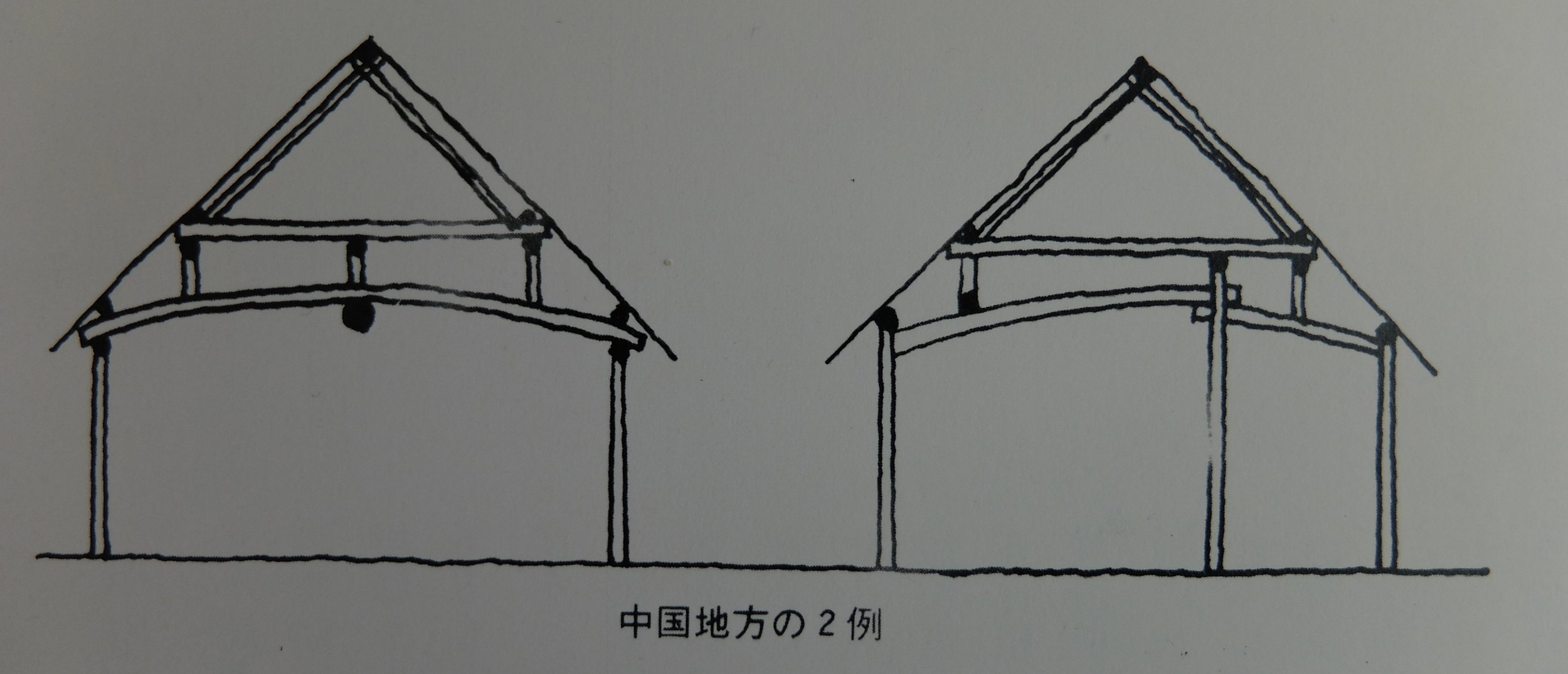In this and the next few instalments of this series on roof framing, we will consider gasshо̄-zukuri (合掌造り, lit. ‘praying hands construction’) roof framing, a style of minka found primarily in the basin of the Shо̄ River (Shо̄-gawa 庄川), which flows northwards from the northern part of Gifu Prefecture and though western Toyama prefecture, emptying into Toyama Bay at Takaoka City.
The famed gasshо̄-zukuri minka of Shirakawa-go, Gifu Prefecture.
In principle, gasshо̄-zukuri framing is not very different from the most general type of sasu-gumi (叉首組) construction discussed in previous posts. But as the huge, steeply pitched gasshо̄ roof spaces consist of three, four or even five ‘attic’ levels that are used for raising silkworms, and as sericulture requires good light and ventilation, these roofs must be gabled, with multiple large openings in the gable walls. This is in contrast to the hipped roofs that result from the tripod configuration of typical sasu-gumi framing.
In the region in which gasshо̄-zukuri minka are found, the floor above ground level is known as shita-ni-kai (したニ階, lit. ‘lower second floor’), the floor above that is called the ue-ni-kai (うえ二階, lit. ‘upper second floor’), and the floor above that is the sora-ni-kai (そら二階, lit. ‘sky second floor’). These upper storeys are floored with reeds or timber slats, again to maximise ventilation for the silkworms and their only food, mulberry leaves. It is said that if everything is quiet, the sound of silkworms munching their mulberry leaves on the attic floors above can be heard by the inhabitants on the ground floor.
An upper floor of a gasshо̄-zukuri minka with timber slat flooring.
Diorama showing suspended reed mats holding silkworms and mulberry leaves.
As discussed in a previous post, the lower roof beam framing in gasshо̄-zukuri makes use of bent ‘hockey stick’ beams known as chо̄na-bari (ちょうな梁 or 手斧梁), to account for the height difference between the taller inner jо̄-ya (上屋) or central shu-ya (主屋) posts and the shorter, outer ge-ya (下屋) posts. There is another layer of beams called narashi (ならし) or gasshо̄-bari (合掌梁) over these chо̄na-bari, making the beam framing a two tiered construction.
Cutaway model of a gasshо̄-zukuri minka, clearly showing the chо̄na-bari and three attic floors.
The principal rafters (sasu 叉首) in gasshо̄-zukuri are themselves called gasshо̄, and are particularly magnificent timbers, sometimes 30cm or more square or round; this is necessary both so that they don’t deflect over their long length and for them to be able to carry the large loads from multiple attic floors. To these gasshо̄ are attached intermediate horizontal transverse members called kainagi (かいなぎ) or mizu-bari (水梁, lit. ‘water beam’), which act as both ties to prevent the gasshо̄ spreading or sagging and as beams to support the attic floors.
The uppermost attic floor of a gasshо̄-zukuri minka, partly floored with reed. Note the massive sasu.
It is because of these special characteristics and due to its grand scale that gasshо̄-zukuri framing is classified separately to standard sasu-gumi construction. Recall that in sasu-gumi construction, the principal rafters running from the end of the ridgepole down to the short or ‘gable’ side of the roof are known as oi-sasu (追い叉首, lit. ‘following sasu’; these rafters, together with the corner sasu that make up half of the pyramid structure that gives these roofs their strength against lateral forces, form the end plane of the hipped roof. In some gasshо̄-zukuri, these members may survive somewhat atavistically, concealed within the gabled roof space, as if someone had taken an existing hipped roof and built a gabled roof over top of it, which may be the case. Instead of forming the end plane of a hipped roof as in the sasu-gumi, they serve as diagonal bracing members (sujikai 筋違). What would in a hipped roof be the corner sasu (sumi-sasu 隅叉首, lit. ‘corner principal rafter’) are known in a gabled roof as sumi-gasshо̄ (隅合掌, lit. ‘corner gasshо̄’) or о̄-hagai (大はがい). These members together preserve the triangulating function of the tripod or pyramid framing in the sasu-gumi, and prevent the gasshо̄-zukuri roof from toppling under longitudinal wind or earthquake loads. This method of bracing is only seen in gasshо̄-zukuri and not in other forms of Japanese minka.
Illustration of the peculiar ‘hipped roof within a gable roof’ construction of some gasshо̄-zukuri minka.



















































































































